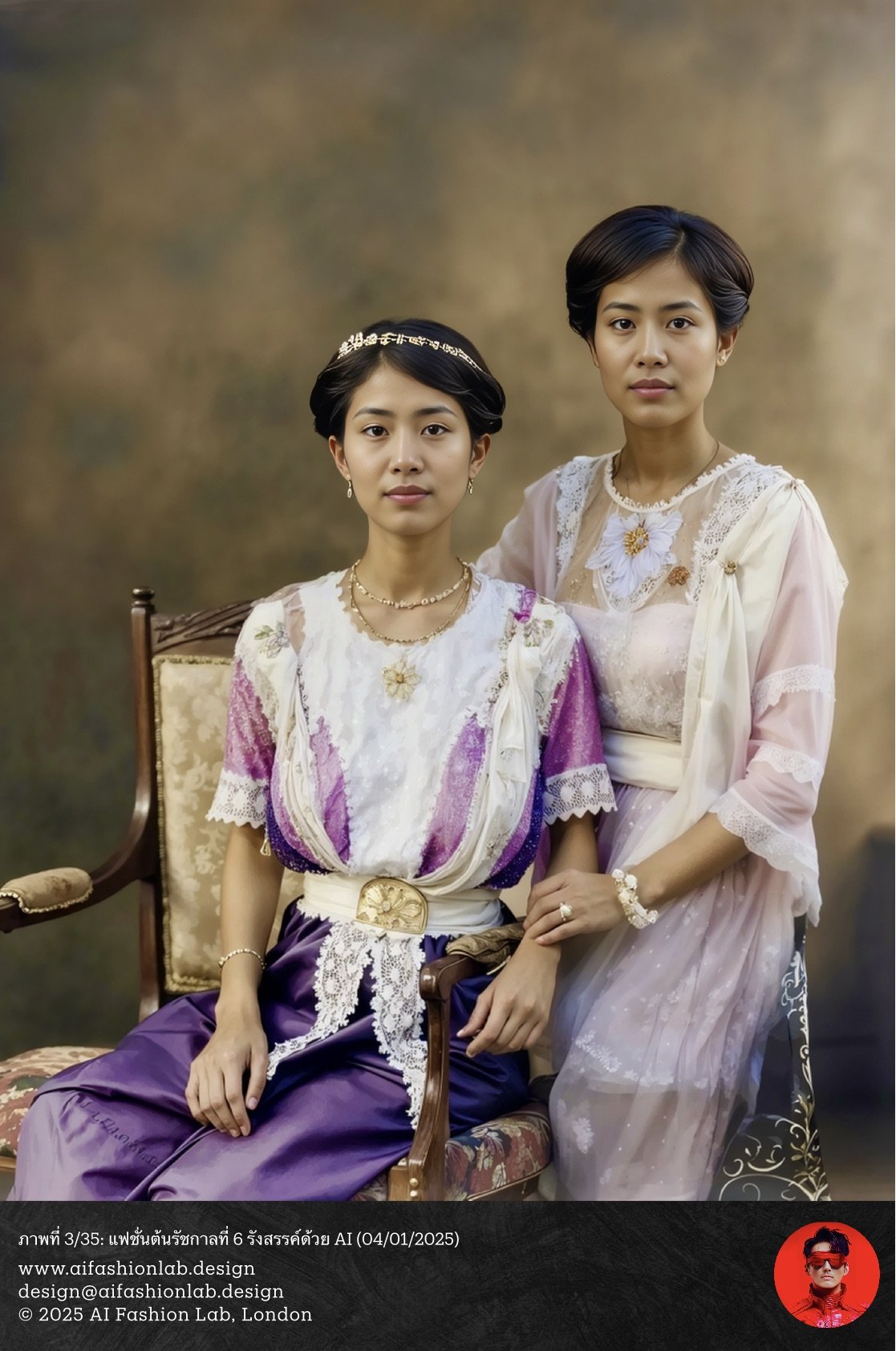Recreating Early Rama VI Era Fashion (1910–1920) with AI: A Creative Journey
One of the unique challenges of this endeavour lies in the distinct characteristics of Thai fashion during the reign of King Rama VI. The era was marked by a fascinating hybridisation of Western and Thai styles. Women often wore elaborate chong kraben (a traditional lower garment) paired with tailored blouses, inspired by Edwardian fashion but adjusted to suit Thai tastes and traditions.
Recreating Early Rama VI Era Fashion (1910–1920) with AI: A Creative Journey
Today, as London finds itself in the grip of a biting chill at -2°C, I have chosen to spend the weekend indoors, channeling my energy into a creative and historically significant endeavour. My objective is to train an AI model capable of authentically recreating the fashion of the early Rama VI era, spanning 1910 to 1920. This project has proven to be both meticulous and profoundly rewarding.
One of the unique challenges of this endeavour lies in the distinct characteristics of Thai fashion during the reign of King Rama VI. The era was marked by a fascinating hybridisation of Western and Thai styles. Women often wore elaborate chong kraben (a traditional lower garment) paired with tailored blouses, inspired by Edwardian fashion but adjusted to suit Thai tastes and traditions. The silhouette featured a blend of Western corseted forms and looser Thai designs, while accessories like belts, jewellery, and lace details added layers of sophistication. Hairstyles, too, reflected a transitional period, with upswept buns adorned with decorative combs or floral accents, echoing both Thai traditions and Western influences.
Recreating these nuanced elements using AI posed a significant challenge. Many existing LoRAs trained on Thai national costumes rely heavily on modern references, often resulting in designs that feel overly contemporary and detached from the historical essence of the period. Additionally, the chong kraben is particularly difficult for AI to interpret due to its unique structure and cultural specificity. Through experimentation, I discovered that using the term "Indian dhoti" in prompts yielded better results, as the AI recognised the garment's similarities more readily.
To ensure historical accuracy, I began by carefully curating 50 archival photographs from the National Archives of Thailand. These images, depicting real individuals from King Rama VI’s early reign, were selected for their consistent representation of costumes and hairstyles. Each photograph underwent a meticulous colourisation process, followed by corrections and enhancements using AI, to achieve a lifelike and refined quality. Some of these restored images may already be familiar to those who follow my page. These 50 perfected visuals formed the foundation of my dataset.
For this project, I utilised the Krea platform and trained the model on the ComfyUI Flux Dev base model. This framework provided a robust starting point for developing a nuanced and historically accurate outcome. While some AI platforms can train models with as few as three images, I used all 50 to ensure a comprehensive understanding of the era’s fashion.
Once the dataset was prepared, the training process itself was relatively efficient. The outcomes exceeded my expectations—out of every 10 generated images, the majority were impressively realistic, requiring minimal or no adjustments. The results highlight the importance of patience and using accurate historical references when training AI models.
This project has demonstrated that, while recreating a specific historical period requires dedication, the payoff is immense. By carefully integrating Thai and Western elements, the AI-generated images capture the elegance, authenticity, and hybridised spirit of early 20th-century Thai fashion. I am delighted to share these results and invite your feedback on how well the AI has succeeded in bringing this era to life.
สร้างสรรค์แฟชั่นยุคต้นรัชกาลที่ 6 (พ.ศ. 2453–2463) ด้วย AI: การเดินทางแห่งความสร้างสรรค์
วันนี้ลอนดอนหนาวจัดด้วยอุณหภูมิ -2°C ผมจึงตัดสินใจใช้เวลาสุดสัปดาห์อยู่ในบ้านและทุ่มเทให้กับโครงการสร้างสรรค์ที่มีความสำคัญทางประวัติศาสตร์ เป้าหมายของผมคือการฝึกโมเดล AI ให้สามารถสร้างภาพแฟชั่นที่สะท้อนความงามในยุคต้นรัชกาลที่ 6 ระหว่างปี พ.ศ. 2453–2463 ได้อย่างสมจริง ซึ่งโครงการนี้เป็นงานที่ต้องใช้ความพิถีพิถันอย่างมาก แต่ก็คุ้มค่าที่ได้ทำ
หนึ่งในความท้าทายของโครงการนี้คือการถ่ายทอดเอกลักษณ์ของแฟชั่นไทยในยุคต้นรัชกาลที่ 6 ซึ่งโดดเด่นด้วยการผสมผสานระหว่างสไตล์ตะวันตกและไทย ชุดในยุคนี้มักประกอบด้วย โจงกระเบน ที่ถูกจับคู่กับเสื้อเบลาส์ที่ได้รับแรงบันดาลใจจากแฟชั่นยุคเอ็ดเวอร์เดียน แต่ปรับให้เข้ากับรสนิยมและวิถีชีวิตของคนไทย รูปทรงของเสื้อผ้าจึงผสมผสานความกระชับตามแบบตะวันตกเข้ากับความพลิ้วไหวแบบไทย รายละเอียดของเครื่องประดับ เช่น เข็มขัด เครื่องประดับทอง และลูกไม้ เพิ่มความสง่างามให้กับชุด นอกจากนี้ ทรงผมยังสะท้อนยุคเปลี่ยนผ่าน โดยมวยผมที่ตกแต่งด้วยหวีประดับหรือดอกไม้ แสดงถึงความงดงามที่ผสมผสานทั้งวัฒนธรรมไทยและตะวันตก
การสร้างองค์ประกอบที่ซับซ้อนเหล่านี้ด้วย AI ไม่ใช่เรื่องง่าย โมเดล LoRA ที่มีอยู่มักใช้ภาพอ้างอิงร่วมสมัย ซึ่งผลลัพธ์ที่ได้มักดูทันสมัยเกินไปและไม่สอดคล้องกับประวัติศาสตร์ อีกทั้ง โจงกระเบน ยังเป็นเครื่องแต่งกายที่ AI ไม่สามารถแปลความได้อย่างถูกต้อง ผมพบว่าการใช้คำว่า "Indian dhoti" ในคำสั่งจะให้ผลลัพธ์ที่ดีกว่า เนื่องจาก AI เข้าใจความคล้ายคลึงของเสื้อผ้าทั้งสองแบบได้ง่ายกว่า
เพื่อให้มั่นใจในความถูกต้องตามประวัติศาสตร์ ผมเริ่มต้นด้วยการคัดเลือกภาพถ่ายเก่า 50 ภาพจากหอจดหมายเหตุแห่งชาติ ภาพเหล่านี้แสดงให้เห็นบุคคลในยุคต้นรัชกาลที่ 6 โดยผมเลือกจากความสอดคล้องของรูปแบบชุดและทรงผม จากนั้นผมนำภาพเหล่านี้มาลงสีด้วยความพิถีพิถัน พร้อมทั้งแก้ไขและปรับปรุงคุณภาพด้วย AI เพื่อให้ได้ภาพที่ดูสมจริงและละเอียดลออ ภาพที่ได้รับการบูรณะเหล่านี้บางส่วนอาจคุ้นตาสำหรับผู้ติดตามเพจของผม ภาพทั้งหมด 50 ภาพที่ได้รับการปรับแต่งจนสมบูรณ์นี้กลายเป็นชุดข้อมูลพื้นฐานสำหรับการฝึกโมเดล
สำหรับโครงการนี้ ผมใช้แพลตฟอร์ม Krea และฝึกโมเดลบนฐาน ComfyUI Flux Dev ซึ่งเป็นพื้นฐานที่แข็งแกร่งในการพัฒนาผลงานที่มีความลึกซึ้งและสอดคล้องกับประวัติศาสตร์ แม้ว่าแพลตฟอร์ม AI บางแห่งจะสามารถฝึกโมเดลได้ด้วยภาพเพียง 3 ภาพ แต่ผมเลือกใช้ภาพทั้งหมด 50 ภาพเพื่อให้ได้ผลลัพธ์ที่ครอบคลุมและแม่นยำยิ่งขึ้น ผลลัพธ์ที่ได้เกินความคาดหมายของผม ในทุกๆ การสร้างภาพ 10 ครั้ง ส่วนใหญ่ให้ผลลัพธ์ที่สมจริงและต้องการการปรับแต่งเพียงเล็กน้อยหรือไม่ต้องปรับเลย
โครงการนี้แสดงให้เห็นว่า แม้การสร้างสรรค์ที่อ้างอิงประวัติศาสตร์เฉพาะยุคจะต้องอาศัยความอดทนและการค้นคว้าที่ละเอียดถี่ถ้วน แต่ผลลัพธ์ที่ได้ก็คุ้มค่ามาก การผสมผสานระหว่างสไตล์ไทยและตะวันตกทำให้ภาพที่สร้างขึ้นโดย AI สามารถถ่ายทอดความสง่างาม ความถูกต้อง และจิตวิญญาณของแฟชั่นไทยในช่วงต้นศตวรรษที่ 20 ได้อย่างสมบูรณ์แบบ ผมรู้สึกยินดีอย่างยิ่งที่จะแบ่งปันผลลัพธ์ของโครงการนี้ และอยากรับฟังความคิดเห็นจากทุกท่านเกี่ยวกับความสำเร็จของ AI ในการนำเสนอยุคสมัยอันงดงามนี้ครับ
#aifashionlab #AI #aiartist #aiart #aifashion #aifashiondesign #aifashionstyling #aifashiondesigner #fashion #fashionhistory #historyoffashion #fashionstyling #fashionphotography #digitalfashion #digitalfashiondesign #digitalcostumedesign #digitaldesign #digitalaiart #promptography #promptographer #prompts #fashionpromptography



































